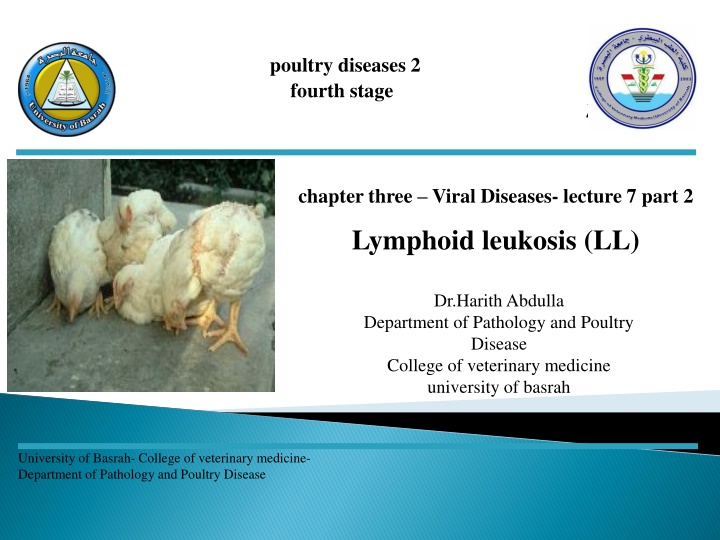
Lymphoid Leukosis in Poultry: Causes, Symptoms, and Prevention
Learn about Lymphoid Leukosis (LL), a neoplastic disease affecting adult chickens, its etiology, clinical signs, post-mortem lesions, differential diagnosis, and prevention strategies. Identify important aspects such as incubation period, method of spread, and diagnostic methods.
Download Presentation

Please find below an Image/Link to download the presentation.
The content on the website is provided AS IS for your information and personal use only. It may not be sold, licensed, or shared on other websites without obtaining consent from the author. If you encounter any issues during the download, it is possible that the publisher has removed the file from their server.
You are allowed to download the files provided on this website for personal or commercial use, subject to the condition that they are used lawfully. All files are the property of their respective owners.
The content on the website is provided AS IS for your information and personal use only. It may not be sold, licensed, or shared on other websites without obtaining consent from the author.
E N D
Presentation Transcript
poultry diseases 2 fourth stage chapter three Viral Diseases- lecture 7 part 2 Lymphoid leukosis (LL) Dr.HarithAbdulla Department of Pathology and Poultry Disease College of veterinary medicine university of basrah University of Basrah- College of veterinary medicine- Department of Pathology and Poultry Disease
Lymphoid leukosis (LL) Lymphoid leukosis is a bursal dependent neoplastic disease of adult chickens ( over 14 16 weeks of age). LL characteristically produces lymphoid tumors, liver and spleen, other visceral organs such as ovary and lungs may also affected . O Etiology: Etiology: Small RNA leukosis / sarcoma virus . O Incubation period Incubation period : : 14 30 weeks . O Method Method of spread of spread :- 1. Transovarian . 2. Lateral transmission . 3. Blood sucking parasites . particularly in
O Clinical signs: Clinical signs: 1 1.The disease is chronic in nature ,but affected birds may .The disease is chronic in nature ,but affected birds may die without signs. die without signs. 2.Pale shriveled combs . 3. Progressive emaciation and diarrhea. 4.Total loss may approach 20% . 5.Losses most severe after onset of egg production 6.Abdominal enlargement. 7.Blood blisters may occur in the skin ,their rupture causing hemorrhage.
OPost Post mortem lesions : mortem lesions : 1. Hepatomegaly : The liver is filling the entire abdominal cavity ,(Big Liver Disease). It is firm, fibrous, and gritty. 2.Enlarged bursa of Fabricius . 3.Tumors on the mesentery and other abdominal viscera. 4.Tumors are soft, smooth, and glistening. 5.Tumors may be nodular ,miliary ,diffuse or combination of these forms. 6.Sometime tumors in the bones .
Differential Differential Diagnosis: 1. Marek s disease(Visceral form) . 2. Avian tuberculosis . 3. Coligranuloma. 4. Histomoniasis {Black Head Disease} . ODiagnosis Diagnosis : : 1. Signs . 2. Post mortem lesions:- A. Bursa of Fabricius enlargement . B. Lack of nerve involvement . 3. Histopathology . 4. ELISA. Diagnosis:
Prevention: 1. Elimination of the virus from breeder hens . A. Test and slaughter . B. Virus is spread to the progeny . 2 . Genetic resistant birds. 3 . Vaccination.
O Mareks disease 1. Age : Young and adult . Nerves: Are affected . Skin : Is affected . Bursa of Fabricius is mainly not involved. O L.L 1.Age:Over 14 16 weeks. 2.Nerves: Not involved . 3.Skin: Is not affected . 4.Bursa of Fabricius:Is the target organ. 2. 3. 4.
